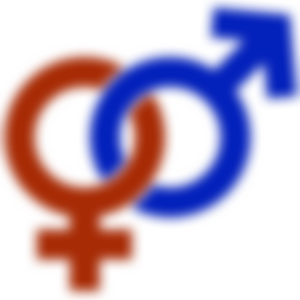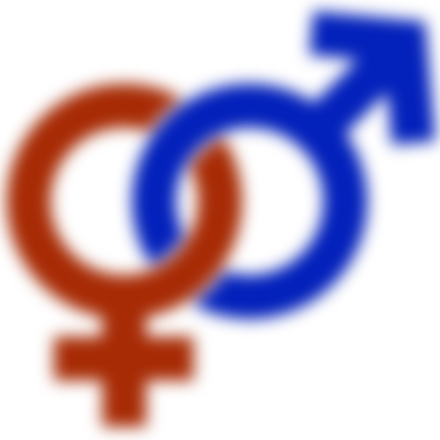Gender is the range of characteristics pertaining to, and differentiating between femininity and masculinity. Depending on the context, this may include sex-based social structures (i.e., gender roles) and gender identity.Most scholars agree that gender is a central characteristic for social organization. Most cultures use a gender binary, having two genders (boys/men and girls/women); those who exist outside these groups may fall under the umbrella term non-binary. Some societies have specific genders besides "man" and "woman", such as the hijras of South Asia; these are often referred to as third genders (and fourth genders, etc.).

Gender symbols intertwined. The red (left) is the female Venus symbol. The blue (right) represents the male Mars symbol.
Sexologist John Money is often regarded as the first to introduce a terminological distinction between biological sex and gender role in 1955 although Madison Bentley had already in 1945 defined gender as the "socialized obverse of sex". Before Money's work, it was uncommon to use the word gender to refer to anything but grammatical categories However, Money's meaning of the word did not become widespread until the 1970s, when feminist theory embraced the concept of a distinction between biological sex and the social construct of gender. Most contemporary social scientists,[11][12][13] behavioral scientists and biologists, many legal systems and government bodies, and intergovernmental agencies such as the WHO,make a distinction between gender and sex.
How to identify gender and its roles:

Gender depicted as an ambiguous phenomenon, by a young Swedish actor
Gender identity refers to a personal identification with a particular gender and gender role in society. The term woman has historically been used interchangeably with reference to the female body, though more recently this usage has been viewed as controversial by some feminists.
In religion:

This topic includes internal and external religious issues such as gender of God and deities creation myths about human gender, roles and rights (for instance, leadership roles especially ordination of women, sex segregation, gender equality, marriage, abortion, homosexuality).
According to Kati Niemelä of the Church Research Institute, women are universally more religious than men. They believe that the difference in religiosity between genders is due to biological differences, for instance usually people seeking security in life are more religious, and as men are considered to be greater risk takers than women, they are less religious. Although religious fanaticism is more often seen in men than women.
Gender and Society:
Their languages;
Natural languages often make gender distinctions. These may be of various kinds, more or less loosely associated by analogy with various actual or perceived differences between men and women. Some grammatical gender systems go beyond, or ignore, the masculine-feminine distinction.[better source needed]
Many languages include terms that are used asymmetrically in reference to men and women. Concern that current language may be biased in favor of men has led some authors in recent times to argue for the use of a more gender-neutral vocabulary in English and other languages.
Several languages attest the use of different vocabulary by men and women, to differing degrees. See, for instance, Gender differences in Japanese. The oldest documented language, Sumerian, records a distinctive sub-language only used by female speakers. Conversely, many Indigenous Australian languages have distinctive registers with a limited lexicon used by men in the presence of their mothers-in-law (see Avoidance speech). As well, quite a few sign languages have a gendered distinction due to boarding schools segregated by gender, such as Irish Sign Language.
Several languages such as Persian or Hungarian are gender-neutral. In Persian the same word is used in reference to men and women. Verbs, adjectives and nouns are not gendered. (See Gender-neutrality in genderless languages)
Grammatical gender is a property of some languages in which every noun is assigned a gender, often with no direct relation to its meaning. For example, the word for "girl" is muchacha (grammatically feminine) in Spanish, Mädchen (grammatically neuter) in German,and cailín (grammatically masculine) in Irish.
The term "grammatical gender" is often applied to more complex noun class systems. This is especially true when a noun class system includes masculine and feminine as well as some other non-gender features like animate, edible, manufactured, and so forth. An example of the latter is found in the Dyirbal language. Other gender systems exist with no distinction between masculine and feminine; examples include a distinction between animate and inanimate things, which is common to, amongst others, Ojibwe, Basque and Hittite; and systems distinguishing between people (whether human or divine) and everything else, which are found in the Dravidian languages and Sumerian.
Several languages employ different ways to refer to people where there are three or more genders, such as Navajo or Ojibwe.
Conclusion:
We should respect all type of gender and never disheart any of them and we should never obliterate their role in society.
Thank you.....!!!!


